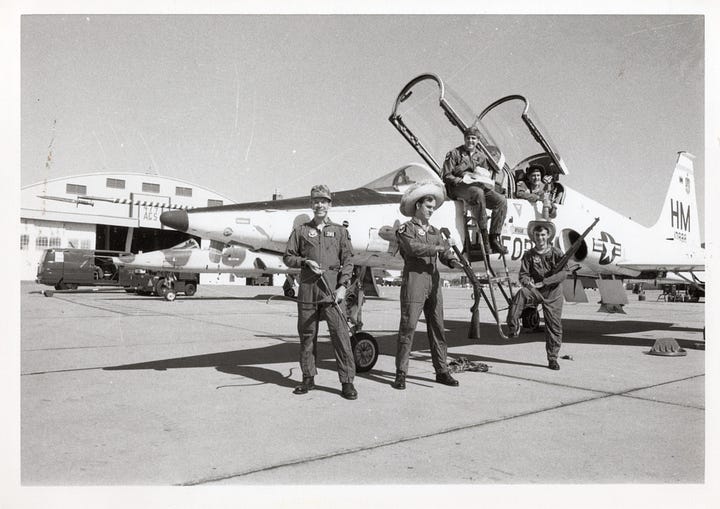As we went through the bombing missions, I regularly hit bullseyes, or my bombs were very close. I was having a great time. The instructor pilots didn’t know what to say about my bombing skills.
The Lead-In Fighter Trainer (LIFT) program operated from 1975 until it ended in 1993. We called it fighter lead-in, so not quite the same as the official name. Getting the OV-10 out of pilot training ended up sending me to lead-in training twice.
LIFT operated out of Holloman, AFB, Alamogordo, NM. The program introduced pilots coming out of pilot training, on their way to fighter aircraft, to basic combat maneuvers and air-to-ground bomb dropping.
The T-38 Talon was flown for the second half of undergraduate pilot training (UPT). Fighter Lead-In had the trainee pilots flying the AT-38B. This allowed new pilots to learn basic fighter maneuvers while flying a familiar aircraft.


The regular LIFT program was ten weeks long. My first time through was on my way to OV-10 training, and I had no need (by Air Force logic) of any air-to-air training, so I went through a 5-week course that only trained on dropping bombs. There were five pilots in my class. We were a fun bunch!
After three great years flying and instructing in the OV-10, I had to complete the full LIFT course before going to F-16 training.
The AT-38B was a regular T-38 with a gunsight added in the cockpit and a removable bomb rack. The jets also got a fancy paint job. The bomb rack carried six 25 lb. practice bombs. The jets also got a fancy paint job. Compared to even the OV-10, The AT-38B was a very simple aircraft. It was sometimes referred to as the “toy jet.”
We didn’t do any air-to-air flying in the OV-10, so the BFM rides were useful training. Going one-v-one in T-38s was challenging. The jets are quite small, and the turn radius is huge. At times, it was hard to keep the other guy in sight and determine what he was trying to do.
For me, the air-to-ground bombing missions were a different story. In the OV-10, we regularly shot rockets, dropped bombs, and strafed. With the Bronco, I used the same manual “dumb bombing” system installed on the AT-38B.
For manual bombing, you would look up the gunsight mil setting using a set of tables. You needed the type of bomb, the planned dive angle, release altitude, and airspeed. A different mil setting is required for each planned bomb run, such as 10-degree and 30-degree dive attacks. Mil settings were dialed into the gunsight for each bombing pass.
The conventional bomb range had concentric circles with a target (usually a vehicle) in the middle. A range officer would score each bomb with azimuth and distance from the bullseye.
To accurately deliver a bomb, you had to fly the jet to hit the dive angle, planned airspeed, and release altitude with the bombsite pipper on the target. Actually not on the target; the aim point had to be adjusted for winds.
In the OV-10, I was the best on the bombing range. It turned out that the T-28 made for a very stable bombing platform. Remember, most, if not all, of the rest of my Lead-In class had never dropped a bomb.
As we went through the bombing missions, I regularly hit bullseyes, or my bombs were very close. I was having a great time. The instructor pilots didn’t know what to say about my bombing skills. I even had an instructor from another squadron who came to ride in the back seat to see for himself about the guy (me) who everyone was talking about his skills at the range.
Please help me reach my goal of 500 subscribers! Share Land, Fly or Die with your friends and family so I can continue to build my audience.






Tim, Thank you for your years of service to our nation. As a F-16 pilot can you weigh in on sending F-16s to Ukraine? I had thought the A-10 would have been a better choice for their much needed ground support. Your thoughts?
I never realized there was so much calculating involved with dropping a bomb. Now I know why you are so good in math.